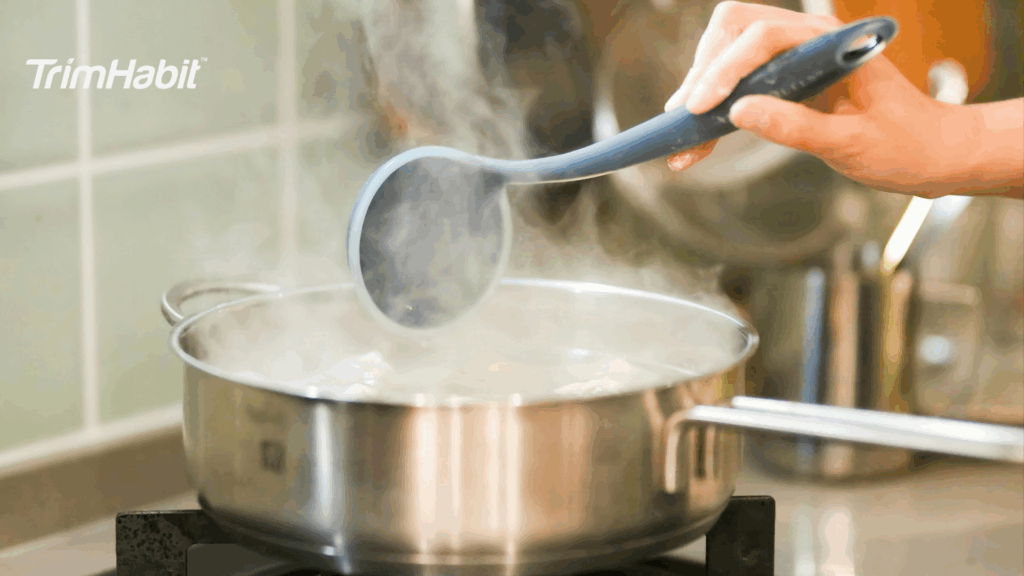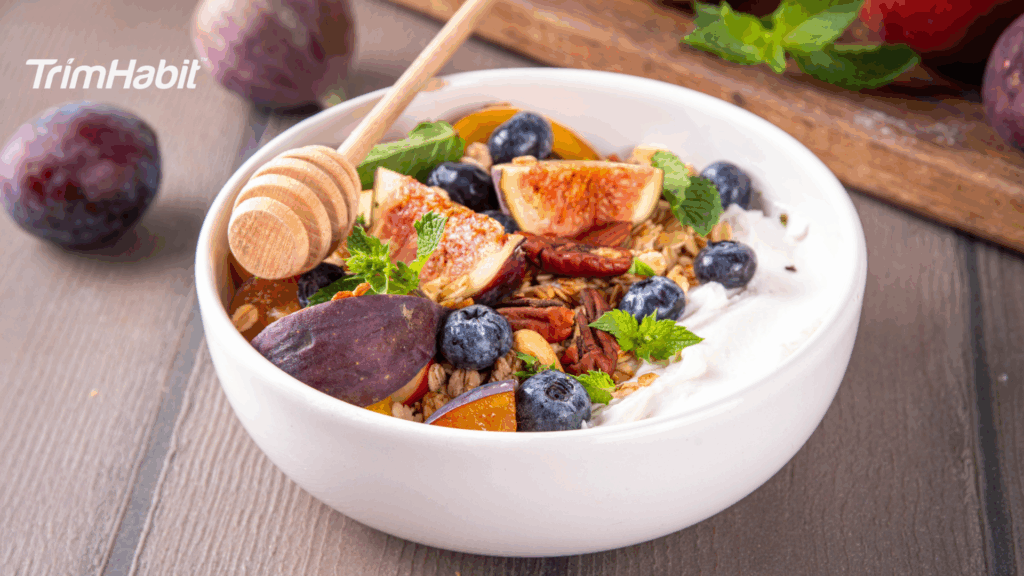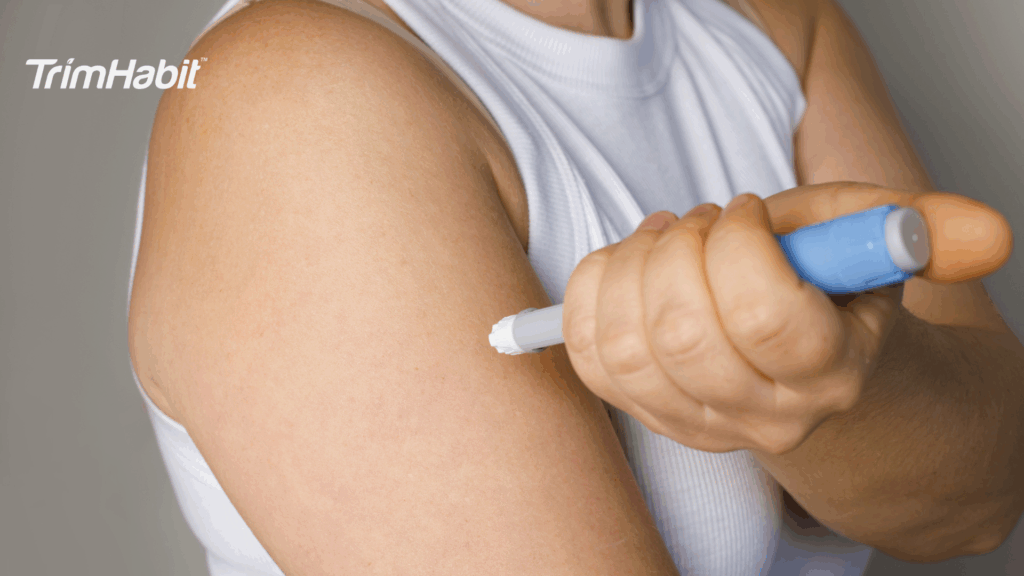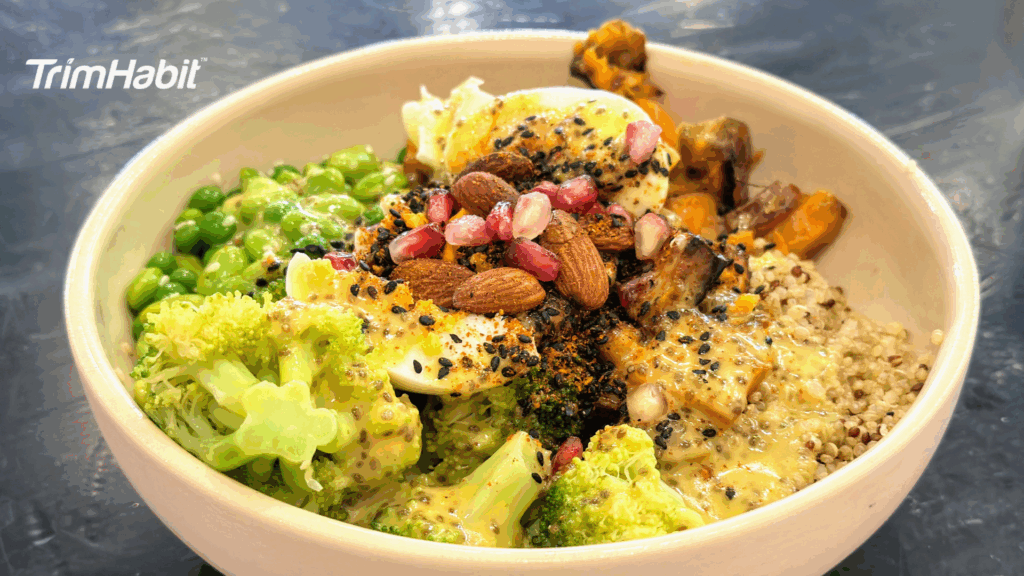Want to lose weight but unsure about how to do it? Do you find yourself questioning what healthy things to snack on to lose weight?
If so, you’re not alone. Snacking can be a real challenge when trying to shed pounds. It’s easy to reach for the wrong kind of snack when you’re hungry, especially if you’re short on time or energy.
Snacking is often associated with weight gain, but it doesn’t have to be that way. Incorporating healthy snacks into your diet can help you lose weight by keeping you full between meals and preventing overeating. The key is choosing nutrient-dense snacks, low in added sugars and unhealthy fats and low in calories.
While there is mixed information concerning whether snacking promotes weight loss, some study suggests that increasing meal frequency through snacking may assist in regulating appetite and enhance blood sugar homeostasis1,2.
This article will explore some healthy snack options to help you lose weight. We’ll also look at the health benefits of certain snack foods and provide some tips for healthy snacking.
Factors To Consider For Healthy Snacking
- The role of portion control.
According to a study, portion control is an effective strategy for managing weight because it helps people reduce their overall calorie intake3.
By controlling the size of your portions, you can limit your calorie intake without drastically changing the types of foods you eat or eliminating any food groups.
The study also highlights the importance of education and awareness about portion sizes, as many people may need to learn what an appropriate portion size looks like. Portion control can be achieved through various methods, such as using smaller plates, measuring serving sizes, or ordering smaller portions at restaurants.
- Importance of balancing macronutrients.
The three macronutrients are fats, proteins, and carbohydrates. Carbohydrates provide energy, proteins help build and repair tissues, and fats are essential for brain function and hormone production.
Every macronutrient contributes to keeping your body satisfied and full, which helps you avoid overeating, curb cravings, and aid in your weight loss journey4.
- The need for nutrient-dense snacks.
Nutrient-dense foods are rich in nutrients but low in calories, and they can help prevent chronic diseases such as heart disease and diabetes5.
These snacks can help keep you feeling full and energized while providing your body with the fuel it needs to function at its best. By incorporating healthier snack options you can improve your overall health and well-being while also supporting your weight loss goals.
Healthy Snacks For Weight Loss
When it comes to snacking for weight loss, fruits and vegetables are a great choice. Not only are they low in calories, but they’re also packed with fiber, vitamins, and minerals that are essential for optimal health.
Some common tasty options include apple slices with almond butter, carrot sticks with hummus, or a fruit salad with a dollop of Greek yogurt. These snacks can help satisfy hunger while providing vital nutrients that can boost your metabolism and support your weight loss goals.
In addition to fruits and vegetables, protein-packed snacks are another excellent choice for weight loss. Protein is known for keeping you full and satisfied, while also helping to build and repair muscles.
Popular options for protein-packed snacks include hard-boiled eggs, cheese, or a protein smoothie with spinach, berries, and of course, Greek yogurt. These snacks not only provide energy but also support overall health and wellness.
Now, let’s explore more healthy snack options and how they can aid in weight loss. These include fruits and vegetables, protein-packed snacks, healthy fats, whole grains, healthy carbs, dairy, and dairy alternatives.
1. Popcorn
Popcorn is a fantastic nutrient-dense snack since it is low in calories and fiber, which can help you feel fuller for longer.
Three cups of air-popped popcorn have 93 calories, 1.1 grams of fat, 18.6 grams of carbohydrates, 3.6 grams of fiber, and 3 grams of protein per serving6.
2. Mixed Nuts
With the appropriate fiber, protein, and healthy fats ratio, nuts make an excellent snack.
In addition to being delicious, they have a lot of health advantages and are satisfying. Studies have also shown that consuming nuts in moderation may aid in weight loss despite their greater calorie and fat content.
You can pick from a wide variety of nuts, such as cashews, walnuts, almonds, Brazil nuts, hazelnuts, pine nuts, macadamia nuts, and pistachios.
A serving of 23 almonds (1/4 cup), or one ounce, has 172 calories, 3 grams of fiber, 6 grams of protein, and 15 grams of healthy fat6.
3. Roasted Chickpeas
Fiber and plant-based proteins can both be found in chickpeas. They are ideal for controlling your weight because they have a meaty texture, nutty flavor, filling fiber, and low protein.
Chickpeas can be made into a crunchy and tasty snack by roasting them.
A serving of a half cup of chickpeas has 150 calories, 8 grams of protein, and 7 grams of fiber6.
4. Fresh Fruit
Portable and simple fruits include oranges, bananas, medium apples (which are high in soluble fiber), pears, grapes, and grapefruit.
Fruit is an excellent little snack because it has fiber and minerals. Combine your fruit with almonds or yogurt to increase the fulfillment factor.
There may be times when eating fresh fruit can be difficult, so consider dried fruit without added sugar or sweeteners.
5. Oatmeal
Oats are a healthy whole grain with a higher protein level than other cereals and a good quantity of fiber.
Oatmeal is a complex carb that aids in fullness without raising blood sugar levels.
You can eat hot or cold oatmeal at home or on the move. It is a very adaptable food.
Per serving (½ cup): 180 calories, 3 grams of fat, 5 grams of protein, 33 grams of carbs, and 4 grams of fiber.
6. Homemade Trail Mix
Combine nuts and dried fruit for fiber, protein, and good fats to make a trail mix. Choose fruits without added sugar and experiment with different flavors. A dried mango with cashews, an apple with almonds, and a cherry with peanuts are all good combinations7,8.
Although homemade trail mix is ideal for on-the-go snacking, be mindful of your portion sizes, as nuts and dried fruit are high in calories.
7. Hard-boiled Eggs
An egg is one of the healthiest and most effective weight-loss foods because they are high in protein, they are very filling9.
Although they had a bad image due to their high cholesterol levels for a long time, current studies indicate that moderate egg consumption, defined as 3–4 eggs per week, may reduce arterial stiffness, a risk factor for heart disease.
A serving of 100 grams of a hard-boiled egg contains 155 calories, 11 grams of fat, 13 grams of protein, and 1.1 grams of total carbohydrates6.
8. Mixed Berries
Due to their properties, mixed berries and Greek yogurt are excellent weight-loss combinations. Berries like blueberries, raspberries, and strawberries are low in calories but high in vitamins, fiber, and antioxidants10,11.
The fiber in berries can help reduce appetite, slow digestion, and promote satiety, making them an excellent addition to a weight loss diet.
Furthermore, the antioxidants in berries can help reduce inflammation, which has been linked to obesity and metabolic disorders.
9. Greek Yogurt
Greek yogurt is an excellent source of calcium and protein, which can help build and maintain muscle mass, boost metabolism, and promote weight loss.
Studies have shown that high-protein diets can help reduce appetite, increase feelings of fullness, and improve body composition by preserving lean muscle mass and reducing body fat12.
For a satisfying and filling breakfast, you can mix plain Greek yogurt with a handful of mixed berries, nuts, and a drizzle of honey. You can also use yogurt as a healthy substitute for sour cream in savory dishes or as a base for smoothies and dips.
10. Protein Smoothies
Protein smoothies are a great way to incorporate essential nutrients and support weight loss. A kale smoothie is an excellent option because kale is high in fiber and low in calories which is ideal for weight loss13.
Kale contains essential nutrients such as vitamins A, C, and K, calcium, and iron, which support optimal health.
The fiber in kale can help reduce appetite, promote satiety, and regulate digestion. You can combine other protein sources such as almond milk, or peanut butter.
Spinach smoothie is another excellent option for weight loss due to their nutrient-dense properties. Spinach is high in vitamins K, A, and C, iron, and magnesium and low in calories, which are essential for overall health14.
Additionally, spinach is rich in antioxidants that lessen oxidative stress and inflammation related to obesity and chronic diseases. When combined with protein sources such as whey protein powder or cottage cheese, spinach smoothies can provide a satisfying meal that can help support weight loss goals. Try using baby spinach in the absence of regular spinach.
Incorporating banana and raspberry smoothies into a healthy diet can also benefit weight loss. Bananas are an excellent source of fiber, vitamins, and minerals that can help reduce appetite and promote satiety15.
Conversely, raspberries are low in calories but high in antioxidants, vitamin C, and fiber which can help reduce inflammation and improve metabolic health.
11. Whole Grain Crackers
Whole grain crackers are a nutritious and convenient snack option for weight loss. These crackers are made from whole grains, such as whole wheat, rye, and oats, which provide fiber, protein, and complex carbohydrates.
Fiber and protein help keep you full for extended periods and can reduce cravings for unhealthy snacks.
Furthermore, the complex carbohydrates found in whole grains are digested slowly, providing a steady release of energy that can help maintain blood sugar levels and prevent overeating16.
In addition to their nutrient content, whole grain crackers are generally lower in calories than other snack options, such as chips or cookies. This means you can snack on them without worrying about consuming excessive calories.
When selecting whole grain crackers, look for options made with whole grains as the first ingredient and low in sodium and added sugar.
For a satisfying snack, you can pair whole-grain crackers with protein-rich dips, such as hummus or natural peanut butter. This snack is more satisfying than potato chips.
12. Dark Chocolate
Dark chocolate is a delicious treat and may aid in weight loss. According to research, dark chocolate can help reduce cravings for salty, sweet, and fatty foods17.
Dark chocolate contains flavonoids that have also been associated with improved insulin sensitivity and decreased inflammation, both of which can aid in weight loss.
To reap the weight-loss benefits of dark chocolate, choosing varieties that are at least 70% cacao and low in added sugars is essential. Consuming dark chocolate in moderation is also important, as it is still high in calories and fat.
As part of a healthy, nutritious snack, even a modest quantity of dark chocolate can be a pleasant approach to support your efforts to lose weight.
13. Whole Wheat Toast
Whole grains, high in fiber, protein, and various vitamins and minerals necessary to maintain excellent health, are used to make whole wheat bread. Whole wheat toast has an abundance of fiber, which helps you feel fuller for longer and fend off cravings and overeating throughout the day.
According to a study, participants who ate whole grains, including whole wheat bread, had a lower BMI and lower belly fat than those who ate refined grains. This is because of the high fiber content in whole grains, which helps keep you full and satisfied for extended periods, reducing overall calorie intake18.
It can be topped with a range of healthy ingredients, such as avocado, eggs, or peanut butter, to create a filling and satisfying breakfast that will help you be energized throughout the day.
You can create a low-calorie meal by adding eggs to toast as a healthy snack. This breakfast replacement meal is a balanced snack rich in fiber and protein.
Per serving: 182 calories, 6 grams of fat (2 grams saturated fats), 20 grams of carbohydrates, 4 grams of sugar, 3 grams of fiber, and 11 grams of protein.
14. Chia seeds
Chia seeds are rich in fiber, plant-based protein, and healthy fats19.
The high fiber content in chia seeds absorbs water in the digestive system, which can help you feel full for extended periods. This can help reduce hunger cravings and prevent overeating throughout the day.
According to a study, eating chia seeds as part of a weight loss program decreased appetite and enhanced feelings of fullness. The study also discovered that people who ate chia seeds saw greater weight loss and better blood sugar control20.
Chia seeds don’t have much flavor, but when soaked in liquid, they create a jelly-like consistency that makes them a fantastic addition to puddings.
Try this easy recipe for a nutritious treat you can have at home or on the go:
Chia Seed Pudding:
- one tablespoon of Chia seeds (15 grams)
- 80 ml or 1/3 cup of preferred dairy or nondairy milk
- 8 grams or half a tablespoon of nut butter or cocoa powder
- 75 grams or half a cup of mixed fruit
- 1-2 teaspoons of sweetener, such as honey or maple syrup, for some natural sweetness
15. Cottage Cheese
Cottage cheese is a low-fat, high-protein cheese rich in calcium and other important nutrients. It is a fantastic source of casein protein, a slow-digesting protein that can aid in keeping you full21.
This may encourage you to consume fewer calories during the day, which may eventually result in weight loss.
Additionally, cottage cheese is low in calories, making it a great snack option for those looking to lose weight.
Add cottage cheese to your salads or eat it as a snack with fruits or vegetables to keep you full and satisfied.
16. String Cheese
String cheese is another excellent cheese option for weight loss. It is a low-fat, high-protein cheese rich in calcium and other vital nutrients22.
For individuals who are busy and constantly on the move, it is a convenient snack that is a perfect choice.
You can eat this cheese as a snack between meals or add it to your salads to increase your protein intake.
Just be sure to choose low-fat or reduced-fat versions of string cheese to keep the calorie and fat content in check.
17. Tuna Salad
Tuna salad can be a healthy and satisfying meal option for those looking to lose weight. Tuna is a lean protein source that promotes feelings of fullness and reduces calorie intake.
In addition, tuna provides an abundance of omega-3 fatty acids, which have been found to have anti-inflammatory effects and may help lower the chance of developing chronic illnesses like cancer and heart disease23,24.
To keep a tuna salad healthy and low in calories, opt for light tuna in water rather than oil, and use low-fat or fat-free yogurt or mayonnaise as a dressing.
Use extra virgin olive oil if you want to use oil.
To make this low-calorie snack:
- Start with a can of light tuna in water and drain any excess liquid.
- Add chopped celery, red onion, and a diced apple for sweetness and crunch.
- Mix in a dressing made from low-fat yogurt, Dijon mustard, and lemon juice for a tangy and flavorful finish.
- Serve the tuna salad on a bed of mixed greens or as a sandwich on whole-grain bread for a filling and healthy meal that will keep you satisfied and energized all day.
18. Almonds
Almonds are a nutritious and delicious snack option that can benefit weight loss. These nuts contain protein, fiber, healthy fats, vitamins, and minerals.
Almonds’ high protein and fiber content can promote feelings of fullness, which may reduce calorie intake and aid in losing weight.
Additionally, the healthy fats found in almonds have been shown to help lower cholesterol levels and reduce the risk of heart disease.
A study found that participants who consumed almonds as a snack had lower overall calorie intake and higher satiety levels than those who consumed a high-carbohydrate snack25.
19. Sparkling Water
Sparkling water is a refreshing and low-calorie alternative to sugary sodas and juices. One cup of sparkling water contains zero calories, which makes it an excellent choice for those who want to stay hydrated without consuming extra calories.
Also, it can aid in reducing appetite and the temptation to binge on unhealthy foods throughout the day.
Furthermore, sparkling water can be a great option for those trying to cut back on sugary drinks.
Sugary drinks have been linked to obesity and other health issues, and drinking sparkling water instead can help reduce added sugar and calorie consumption.
20. Low-calorie Sports Drinks
These drinks provide a convenient and delicious way to replace fluids and electrolytes lost during workouts without adding extra calories to your diet.
A study found that consuming a low-calorie sports drink during exercise helped to increase fat oxidation and decrease body fat in overweight individuals26.
Another study shows that consuming a low-calorie sports drink before exercise improved exercise performance and increased fat oxidation in healthy individuals27.
Electrolytes like sodium, potassium, and magnesium are commonly used in the formulation of low-calorie sports beverages to improve the body’s fluid imbalance.
Since electrolytes are essential for proper muscle function and can become depleted during exercise, leading to cramping and fatigue, low-calorie sports drinks can speed up recovery time and lessen muscular discomfort by replenishing these electrolytes.
One of the critical benefits of low-calorie sports drinks is their low-calorie content.
Unlike traditional sports drinks, which are often high in sugar and calories, low-calorie sports drinks typically contain ten or fewer per serving. This makes them a good alternative if you’re trying to cut your overall calorie intake while still getting the hydration and electrolyte assistance you need.
21. Nut or Seed Butter
Nut and seed butter can be an excellent addition to losing weight. While peanut butter is perhaps the most well-known, many other options, such as almonds, cashew, and sunflower seed butter, are available.
These spreads are rich in protein, fiber, and healthy fats, making them a filling and satisfying snack that can help you feel full for longer.
One of the benefits of nut butter is its naturally sweet taste, which can help to satisfy a sweet tooth without the added sugars found in many processed snacks.
While it’s important to choose a nut butter with no added sugars, the natural sweetness of the nuts can be a great way to curb cravings and prevent overeating.
For example, a tablespoon of almond butter contains only around 100 calories but can provide a filling snack that can keep you going until your next meal.
Nut butter can also be versatile in different recipes, from smoothies to sauces and dressings.
This can make it easier to incorporate into your diet and keep things interesting, helping to prevent boredom and promote adherence to your weight loss goals. Just be sure to watch portion sizes and choose a high-quality, natural nut butter to get the most benefits.
Dairy Product Alternatives
If you’re looking to lose weight and want to reduce or eliminate dairy products from your diet, there are several alternatives you can try. Here are some options:
- Plant-based Milk – replace dairy milk with plant-based milk such as almond milk, soy milk, oat milk, or coconut milk. These alternatives are lower in calories and fat than cow’s milk; some are fortified with calcium and vitamin D.
- Nut-based Cheese – instead of regular cheese, try nut-based cheese from cashews, almonds, or macadamia nuts. These cheeses are lower in fat and calories and can add flavor and texture to dishes.
- Yogurt Alternatives – if you enjoy yogurt, try a plant-based yogurt alternative such as soy yogurt, coconut yogurt, or almond yogurt. These choices can be a healthy source of protein and have fewer calories and fat than regular yogurt.
- Avocado – use mashed avocado to replace cheese or cream in sandwiches, wraps, and dips. Avocado is high in healthy fats and can provide a creamy texture to dishes.
- Hummus – use hummus to replace cheese or cream in sandwiches, wraps, and dips. Hummus is high in protein and fiber and can provide a savory and creamy dish flavor.
Takeaways
Snacking is a critical aspect of any weight loss journey. Choosing snacks rich in vitamins, minerals, and fiber can help satisfy hunger, provide energy, and keep cravings at bay.
Portion control, balancing macronutrients, and incorporating nutrient-dense snacks into your diet are key factors for nutritional snacking.
Incorporating the healthy snack options mentioned above can help support your weight loss goals and improve your overall health and wellness.









